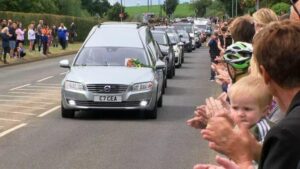On June 2nd, the world of sports suffered the loss of a great legend. Having fought valiantly against motor neurone disease (MND), Rob Burrow, who was considered to be one of the most iconic players for both the Leeds Rhinos and England, passed away at the age of 41. Fans, friends, and family alike are left to mourn a man who gave so much to rugby and became an inspiring figure in the fight against motor neurone disease with his passing. His death marks the end of a remarkable life both on and off the field.

In recognition of Burrow’s life and legacy, a ceremony was held at the Leeds Civic Hall. People who knew him best and people who were inspired by his strength and determination came together for a gathering that was both meaningful and moving. Not only was the event a time to remember his remarkable career, but it was also a moment to reflect on his impact beyond the realm of rugby, particularly his courageous and tireless work helping to raise awareness for motor neuron disease (MND).
Burrow was a fan favorite throughout his whole time with Leeds Rhinos, where he played for four years. His daring exploits on the field earned him a reputation for never faltering in his commitment to the squad. Although he was only 5 feet and 5 inches tall, his career was not hindered by his little stature. He played as a scrum-half for the Rhinos and contributed to the team’s success in a number of ways, including winning multiple Super League titles and Challenge Cups. He was famous for his speed, agility, and consistent work ethic. On the international scene, he also proudly represented England, further solidifying his position as a legendary figure in the sport of rugby.
Burrow, on the other hand, did not fully become a hero in the eyes of many people until the years that followed his retirement. A diagnosis of motor neurone disease was made for him in the year 2019, which is a disorder that leads to the gradual degeneration of the motor neurons in the brain and spinal cord, which ultimately results in the loss of muscle strength, paralysis, and his death. Instead of allowing the severity of the sickness to define him, Burrow refused to be defined by it when he received his diagnosis. He chose to make use of his platform to advocate for funding and research in order to assist in the hunt for a solution for the debilitating disorder known as motor neuron disease (MND).
Burrow’s fortitude and tenacity in the face of motor neuron disease (MND) enthralled the nation in the months and years that followed. It was not just in the realm of rugby that he became a hero, but also in the wider community, because of his courageous actions of speaking out, sharing his journey, and continuing to assist those who were impacted by the condition. His attempts to raise money were tireless, and he received an overwhelming number of friends and supporters who rallied behind him in his struggle against motor neurone disease (MND).
The ceremony, which took place at Leeds Civic Hall, was a demonstration of the tremendous amount of admiration and affection that people have for Burrow. People who were close to Rob and his family were among the approximately 180 individuals who gathered to pay their respects. The event was attended by Tanya Curry, the Chief Executive Officer of the Motor Neuron Disease Association, an organization that has profited immensely from Burrow’s activism. Jamie Jones-Buchanan, Burrow’s former colleague, was also present. Jones-Buchanan and Burrow had a long and successful collaboration at Leeds Rhinos. Alongside the Lord Mayor of Leeds, Abigail Marshall Katung, who was instrumental in the event’s planning and organization, James Lewis, the leader of the Leeds City Council, was also present at the event.
Additionally, the ceremony was more than just a celebration of Burrow’s accomplishments in the sporting world. His bravery in the face of adversity and the remarkable impact he had on the community of people living with motor neurone disease were both recognized by those who admired him. His personality and the way he lived life to the fullest, even in the face of the cruel and progressive disease, were celebrated during the service, which included heartfelt tributes as well as a celebration of his individuality.
Above and beyond the confines of the rugby field, Rob Burrow’s legacy will live on. He has become an enduring symbol of strength and hope as a result of his bravery, determination, and altruism in the fight against motor neuron disease (MND). The demise of this individual has left a vacuum not only in the world of rugby but also in the hearts of everyone whose lives were impacted by his narrative. In spite of this, his struggle for a cure will continue, thanks to the ongoing efforts of the Motor Neuron Disease Association and the efforts of individuals who were motivated by his instance.
It became abundantly evident that Burrow’s influence on the sport of rugby as well as the community of people living with motor neurone disease will never be forgotten as the event came to a close and those who had gathered to commemorate Burrow reflected on his incredible life. As a true hero who fought bravely on the pitch and even more so in the fight against motor neurone illness, Rob Burrow will forever be regarded as a hero in Leeds and beyond. His legacy will go on forever.
Robburrow, may you finally rest in peace. There will be no end to your legacy.
